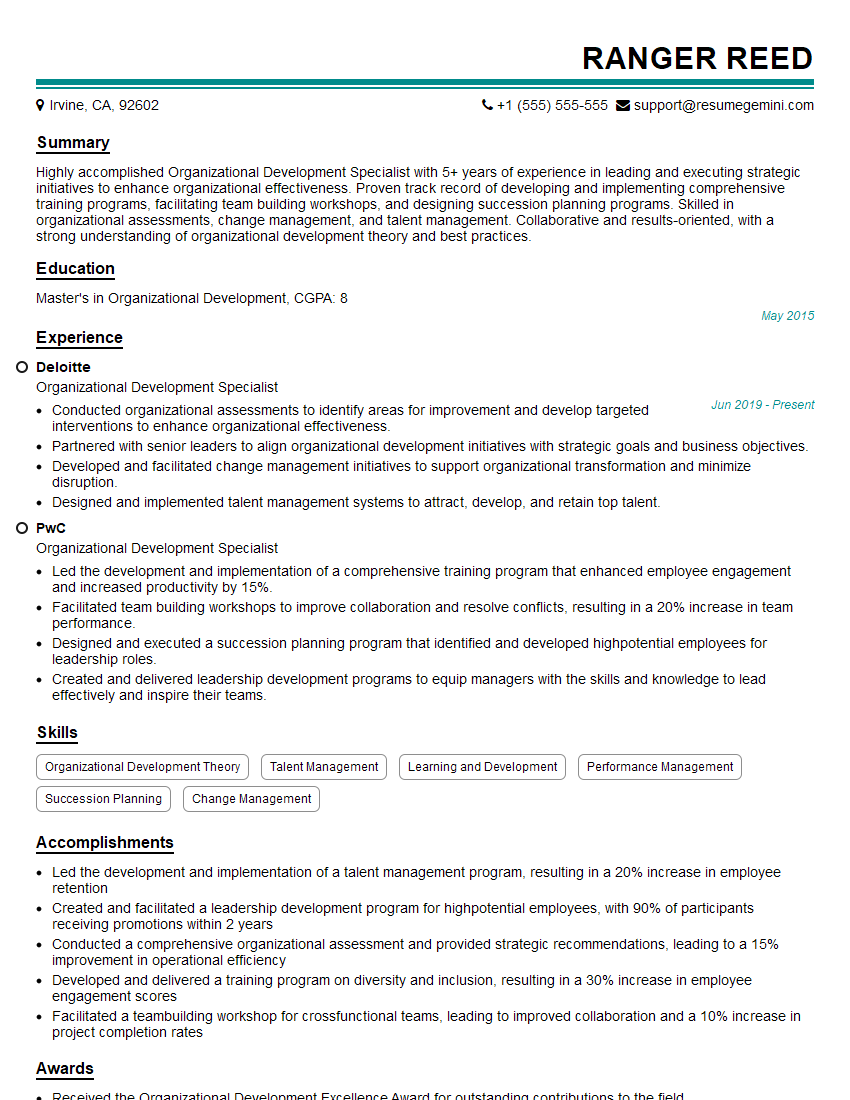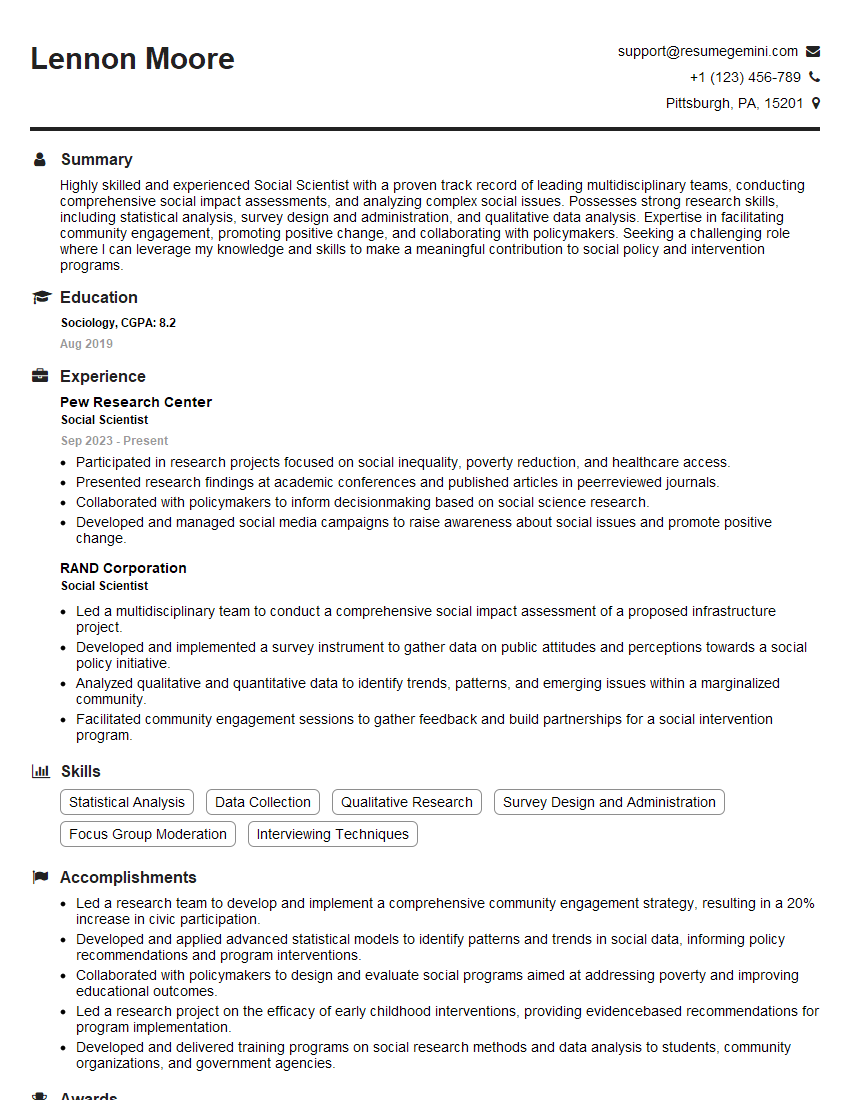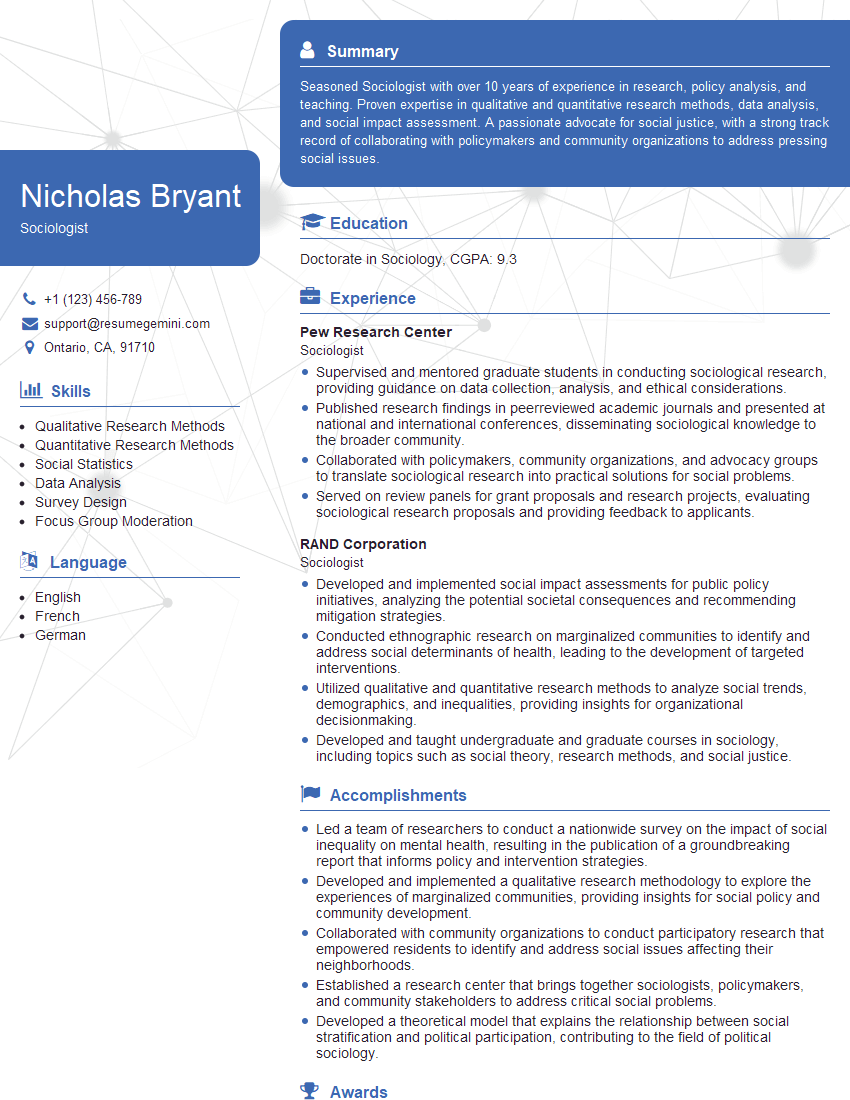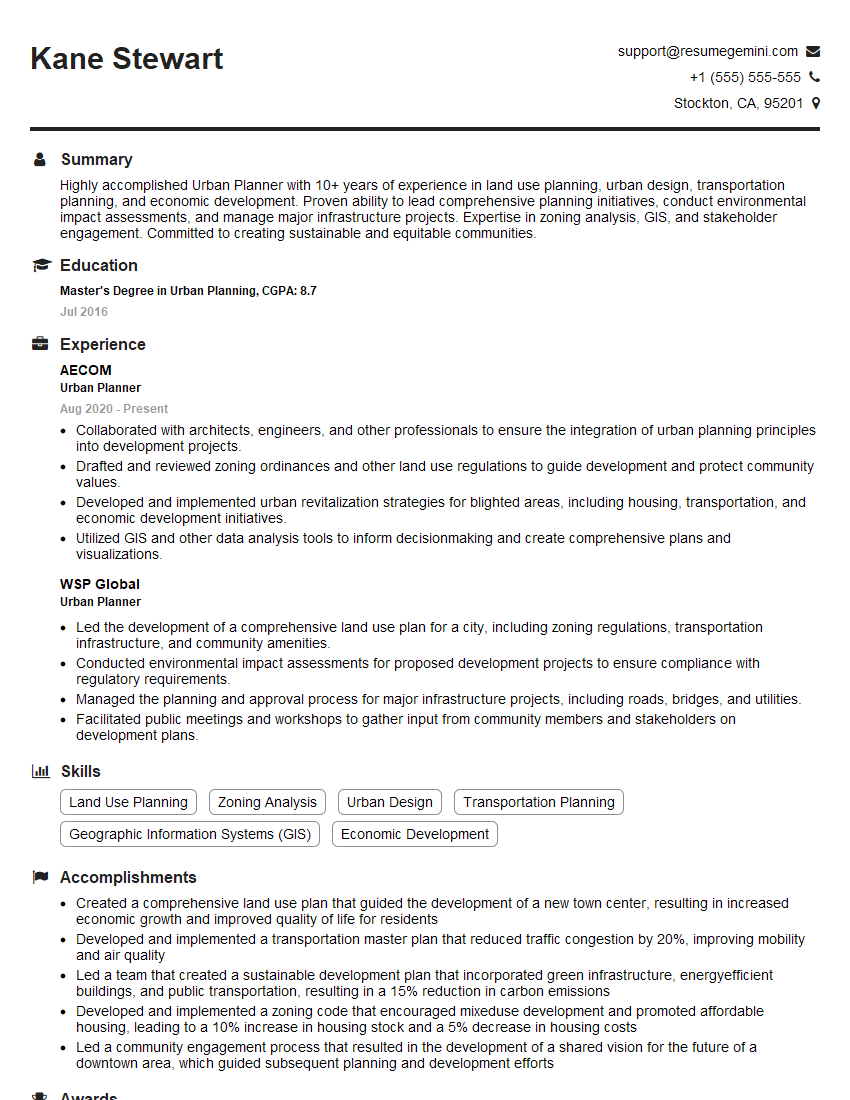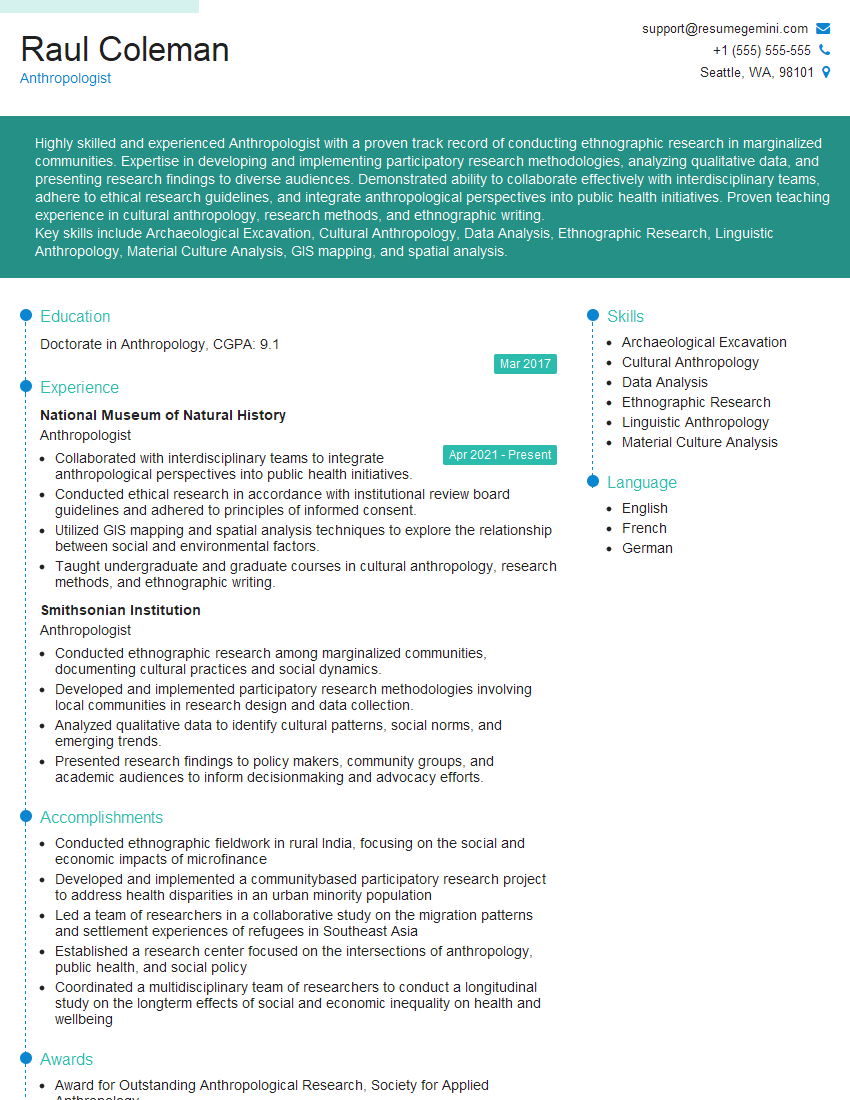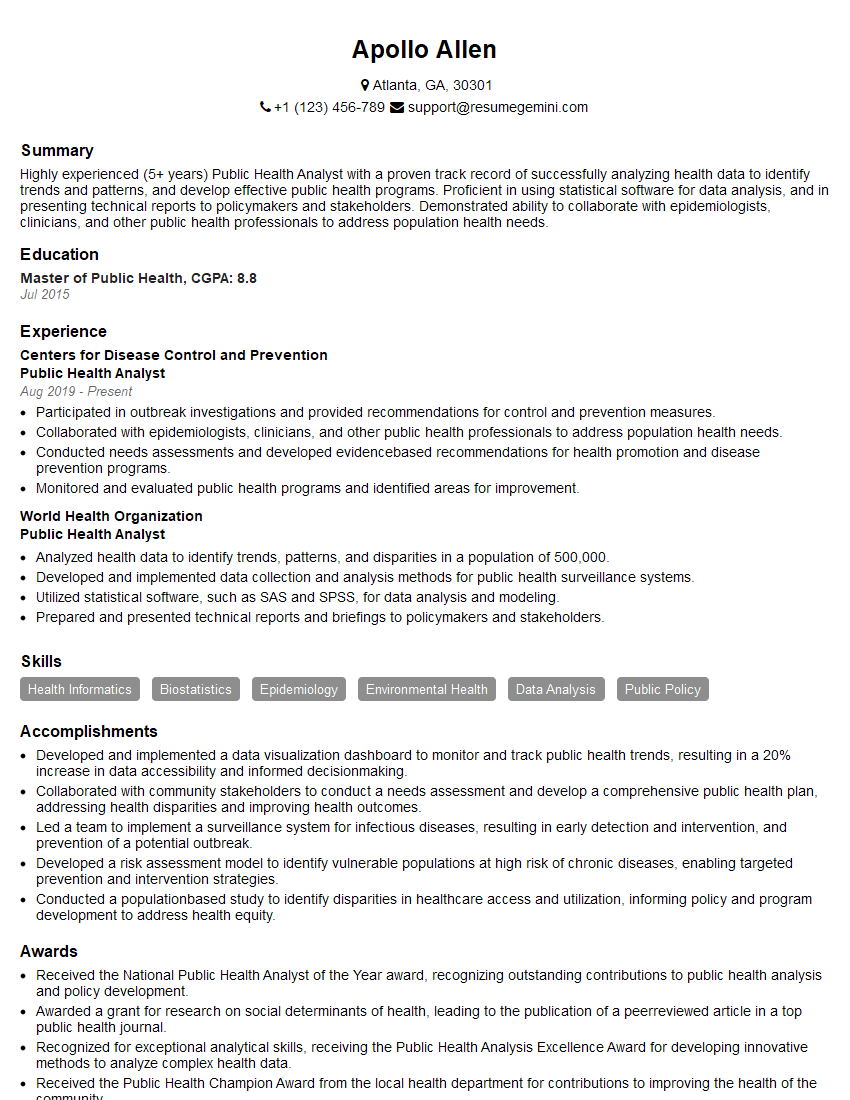Cracking a skill-specific interview, like one for Knowledge of Social Science Theory, requires understanding the nuances of the role. In this blog, we present the questions you’re most likely to encounter, along with insights into how to answer them effectively. Let’s ensure you’re ready to make a strong impression.
Questions Asked in Knowledge of Social Science Theory Interview
Q 1. Explain the difference between qualitative and quantitative research methods in social science.
Qualitative and quantitative research methods represent distinct approaches to understanding social phenomena. Qualitative research focuses on in-depth understanding of experiences, perspectives, and meanings. It employs methods like interviews, focus groups, and ethnography to gather rich, descriptive data. This data is then analyzed thematically or narratively, seeking patterns and insights. Quantitative research, conversely, emphasizes numerical data and statistical analysis. It uses surveys, experiments, and existing datasets to test hypotheses and establish relationships between variables. The goal is to quantify observations and generalize findings to larger populations. Think of it like this: qualitative research is like painting a detailed portrait of a single individual, while quantitative research is like taking a snapshot of a large crowd to understand overall trends.
- Qualitative Example: A researcher conducting in-depth interviews with refugees to understand their experiences of resettlement.
- Quantitative Example: A researcher surveying a large sample of voters to determine their preferred candidate and predict election outcomes.
Q 2. Describe the strengths and weaknesses of positivism and interpretivism in social science research.
Positivism and interpretivism are two major philosophical stances guiding social science research. Positivism, rooted in the natural sciences, assumes an objective reality that can be studied using scientific methods. Researchers strive for objectivity, value-neutrality, and generalizable findings. Interpretivism, conversely, emphasizes the subjective nature of social reality and the importance of understanding meaning and interpretation. Researchers acknowledge the influence of their own perspectives and focus on understanding the world from the participants’ point of view.
- Positivism Strengths: Rigor, replicability, generalizability.
- Positivism Weaknesses: Oversimplification of complex social phenomena, neglect of context and meaning.
- Interpretivism Strengths: Rich understanding of context, nuanced insights into meanings and interpretations.
- Interpretivism Weaknesses: Difficulty in generalizing findings, subjectivity in interpretation, challenges in replicability.
For example, a positivist researcher might use a survey to measure levels of social inequality, aiming for objective data and statistical analysis. An interpretivist, however, might conduct ethnographic fieldwork in a community to understand how people experience and negotiate inequality in their daily lives.
Q 3. How does social constructivism influence our understanding of social phenomena?
Social constructivism posits that social phenomena, rather than being objective realities, are constructed through social interactions and shared meanings. Our understanding of the world isn’t passively received but actively created. Concepts like gender, race, and even money are not inherent but are socially defined and negotiated. This perspective highlights the role of culture, language, and power dynamics in shaping our perceptions and understanding of reality. For instance, what constitutes ‘normal’ behaviour varies widely across cultures, showcasing the constructed nature of social norms. Similarly, our understanding of race is a social construct, with its meaning and implications shifting across time and context. Social constructivism encourages us to critically examine the taken-for-granted aspects of social life and to recognize the role of social processes in shaping our world.
Q 4. Discuss the ethical considerations involved in conducting social science research.
Ethical considerations are paramount in social science research. Researchers have a responsibility to protect participants’ rights and welfare. Key ethical principles include:
- Informed Consent: Participants must be fully informed about the study’s purpose, procedures, and potential risks before agreeing to participate.
- Confidentiality and Anonymity: Researchers must protect participants’ identities and sensitive information.
- Beneficence and Non-Maleficence: Researchers must strive to maximize benefits and minimize harm to participants.
- Justice and Equity: Research should be conducted fairly and equitably, avoiding exploitation or discrimination.
- Integrity and Transparency: Researchers should conduct research honestly and transparently, accurately representing their findings.
A researcher might use pseudonyms to protect participants’ identities or obtain ethics board approval before commencing data collection to ensure adherence to these standards. Failing to uphold these principles can result in serious harm to participants and damage the reputation of the research field.
Q 5. What are the key components of a strong research hypothesis in social science?
A strong research hypothesis in social science should be:
- Clear and Concise: It should state the relationship between variables in a straightforward way.
- Testable: It should be possible to collect data that can either support or refute the hypothesis.
- Specific: It should clearly define the variables being studied and the nature of their relationship.
- Falsifiable: It must be possible to conceive of evidence that would disprove the hypothesis.
- Relevant: It should address a significant research question and contribute to the existing body of knowledge.
For example, instead of a vague hypothesis like “Social media affects mental health,” a stronger hypothesis would be “Increased daily use of social media is associated with higher levels of anxiety among young adults.” This version is more specific, testable, and falsifiable.
Q 6. Explain the concept of operationalization in social science research.
Operationalization is the process of defining abstract concepts into measurable variables. It bridges the gap between theoretical constructs and empirical measurement. For example, the abstract concept of “social support” needs to be operationalized into specific, observable indicators. This might involve measuring the frequency of social interaction, the perceived availability of help from others, or the strength of social ties. Operationalization ensures that researchers are measuring what they intend to measure and allows for objective and replicable research. A poorly operationalized variable can lead to inaccurate or misleading results. For instance, if ‘happiness’ is simply measured by asking ‘Are you happy? Yes/No’, the richness of the concept is lost, leading to an oversimplified measure.
Q 7. How do you ensure validity and reliability in your social science research?
Ensuring validity and reliability is crucial for producing high-quality social science research. Validity refers to the accuracy of a measure; does it actually measure what it is intended to measure? Reliability refers to the consistency of a measure; would you get similar results if you repeated the measurement? Several strategies enhance validity and reliability:
- Triangulation: Using multiple methods (e.g., surveys, interviews, observations) to gather data on the same phenomenon.
- Pilot Testing: Testing the research instruments and procedures on a small sample before conducting the main study.
- Inter-rater Reliability: Having multiple researchers independently code or analyze data to ensure consistency.
- Established Measures: Utilizing well-validated measures that have been used successfully in previous studies.
- Member Checking: In qualitative research, returning findings to participants to ensure accuracy and gain feedback.
For example, a researcher studying job satisfaction could improve validity by using multiple measures (e.g., self-report questionnaires, supervisor ratings, observations of employee behavior). Reliability could be enhanced by using a standardized questionnaire and ensuring consistent administration procedures.
Q 8. Describe different sampling techniques used in social science research and their appropriate applications.
Sampling techniques are crucial for selecting a representative subset of a population for study, allowing researchers to draw inferences about the larger group without studying every individual. Different techniques are appropriate for different research questions and populations.
Probability Sampling: Every member of the population has a known, non-zero chance of being selected. This ensures greater generalizability of findings.
- Simple Random Sampling: Each member has an equal chance of selection (e.g., drawing names from a hat).
- Stratified Random Sampling: The population is divided into strata (e.g., age groups, income levels), and random samples are drawn from each stratum, ensuring representation from all subgroups.
- Cluster Sampling: The population is divided into clusters (e.g., schools, neighborhoods), and a random sample of clusters is selected; all members within the selected clusters are included.
Non-probability Sampling: The probability of selection is unknown, limiting generalizability but often necessary for practical or exploratory reasons.
- Convenience Sampling: Selecting participants readily available (e.g., surveying students in a college cafeteria).
- Purposive Sampling: Selecting participants based on specific characteristics relevant to the research question (e.g., interviewing experts in a field).
- Snowball Sampling: Participants refer other potential participants (useful for hard-to-reach populations).
- Quota Sampling: Similar to stratified sampling, but non-random selection is used within strata.
Example: A researcher studying voting patterns might use stratified random sampling to ensure representation from different age, race, and income groups. A researcher exploring the experiences of homeless youth might utilize snowball sampling to access this hard-to-reach population.
Q 9. What are the limitations of using surveys in social science research?
Surveys, while efficient for gathering large amounts of data, have limitations:
Social Desirability Bias: Respondents may answer questions in a way they believe is socially acceptable, rather than truthfully.
Response Bias: Certain groups may be more or less likely to respond, leading to skewed results. For example, busy professionals might be less likely to complete a lengthy survey than retirees.
Question Wording Bias: The way questions are phrased can influence answers. Leading questions can subtly push respondents toward certain responses.
Lack of Depth: Surveys often lack the depth and richness of qualitative data, limiting the understanding of underlying motivations and contexts.
Sampling Error: Even with careful sampling, there’s always a possibility that the sample doesn’t perfectly represent the population.
Example: A survey on political attitudes might overrepresent individuals with strong opinions, while those with neutral or apathetic views might be underrepresented.
Q 10. Compare and contrast different statistical methods used in quantitative social science research.
Quantitative social science research relies heavily on statistical methods to analyze numerical data. Some common methods include:
Descriptive Statistics: Summarize and describe data. Examples include measures of central tendency (mean, median, mode) and variability (standard deviation, range).
Inferential Statistics: Make inferences about a population based on a sample. Examples include:
- t-tests: Compare the means of two groups.
- ANOVA (Analysis of Variance): Compare the means of three or more groups.
- Correlation: Measure the strength and direction of the relationship between two variables.
- Regression Analysis: Predict the value of one variable based on the values of other variables.
Comparison: Descriptive statistics provide a snapshot of the data, while inferential statistics allow for generalizations beyond the sample. t-tests and ANOVA are used for comparing group means, while correlation and regression examine relationships between variables.
Example: A researcher might use descriptive statistics to summarize the average age and income of survey respondents. They might then use regression analysis to predict voting behavior based on age and income.
Q 11. Explain the concept of causality and how it is established in social science research.
Causality refers to a cause-and-effect relationship between variables. Establishing causality in social science research is challenging but crucial for understanding social phenomena. It requires demonstrating that a change in one variable (independent variable) leads to a change in another (dependent variable).
Establishing causality involves:
Temporal Precedence: The cause must precede the effect in time.
Covariation: The two variables must be correlated; changes in one are associated with changes in the other.
Non-spuriousness: The relationship between the variables must not be due to a third, confounding variable.
Researchers often employ experimental designs, such as randomized controlled trials, to establish causality by manipulating the independent variable and observing its effect on the dependent variable while controlling for confounding variables. However, in many social science contexts, true experiments are not feasible. Researchers rely on quasi-experimental designs or observational studies, combining statistical analysis with careful consideration of potential confounding factors.
Example: To determine if a new educational program improves student test scores (dependent variable), researchers might randomly assign students to a treatment group (receiving the program) and a control group (not receiving the program). A significant difference in test scores between the groups would provide stronger evidence for causality than observational studies alone.
Q 12. Discuss the role of theory in guiding social science research.
Theory plays a vital role in guiding social science research. A theory provides a framework for understanding a phenomenon, posing testable hypotheses, and interpreting research findings. It helps in asking meaningful questions, guiding the research design, and shaping the interpretation of results. Without a theoretical framework, research can be haphazard and lack coherence.
A strong theory:
Provides a clear explanation of a phenomenon.
Generates testable hypotheses.
Offers insights into the relationships between variables.
Can be used to predict future outcomes.
Example: Social learning theory suggests that individuals learn behaviors through observation and imitation. A researcher could use this theory to guide a study exploring the impact of violent media on aggressive behavior in children. The theory provides a framework for developing hypotheses about the relationship between media consumption and aggression, which can then be tested through empirical research. Furthermore, the findings can be interpreted in light of the theory, leading to either support or refinement of the theory.
Q 13. How do you interpret and analyze qualitative data in social science research?
Qualitative data analysis in social science involves interpreting non-numerical data, such as interviews, field notes, and documents. The goal is to understand the meanings, experiences, and perspectives of individuals and groups. This process is often iterative and involves several steps:
Transcription and Data Preparation: Transcribing interviews or organizing other data into a manageable format.
Coding: Identifying themes, patterns, and recurring ideas within the data. Codes are labels applied to sections of the data representing key concepts.
Theme Development: Grouping codes into broader themes that capture the main patterns and meanings emerging from the data. This process involves reviewing and refining themes based on the data.
Interpretation and Narrative Construction: Weaving together the themes and evidence to build a coherent narrative that addresses the research question. This often involves drawing connections between the different themes, considering context, and offering explanations for the findings.
Software such as NVivo or Atlas.ti can assist with managing and analyzing large qualitative datasets.
Example: A researcher studying the experiences of immigrant women might conduct in-depth interviews, transcribe them, code the transcripts for recurring themes (e.g., challenges with language acquisition, discrimination, family separation), and then develop a narrative that describes the diverse experiences and challenges faced by these women.
Q 14. Explain the concept of triangulation in social science research.
Triangulation in social science research involves using multiple methods, data sources, or perspectives to study the same phenomenon. The goal is to increase the validity and reliability of research findings by corroborating evidence from different sources. This helps to reduce bias and provide a more comprehensive understanding.
Types of triangulation:
Methodological Triangulation: Using different research methods (e.g., surveys and interviews) to gather data.
Data Triangulation: Using different data sources (e.g., observations, documents, interviews) to gather information about the same phenomenon.
Researcher Triangulation: Involving multiple researchers in data collection or analysis to minimize individual bias.
Theory Triangulation: Using different theoretical perspectives to analyze the same data.
Example: A researcher studying organizational culture might use surveys to collect quantitative data on employee attitudes, conduct interviews to gather qualitative insights, and observe workplace interactions to obtain additional data. By comparing and contrasting findings across these different methods, the researcher can gain a richer understanding of the organizational culture and increase confidence in the results.
Q 15. What is the significance of peer review in social science research?
Peer review is a cornerstone of rigorous social science research. It’s a process where experts in a field critically evaluate a research paper before publication, ensuring quality, validity, and originality. Think of it as a quality control check, but instead of a factory line, it’s a scholarly community.
Its significance lies in several key areas:
- Ensuring methodological rigor: Reviewers assess the research design, data collection methods, and analysis techniques, identifying any flaws or biases that could compromise the study’s findings. For example, a reviewer might point out a sampling bias that limits the generalizability of the results.
- Improving research quality: Feedback from reviewers allows researchers to refine their work, strengthening arguments, clarifying ambiguities, and improving the overall presentation. It’s a collaborative process that enhances the quality of published research.
- Maintaining academic standards: Peer review helps maintain the integrity and credibility of the field by filtering out substandard or flawed research. This protects the reputation of the journal and the broader academic community.
- Promoting objectivity: By involving multiple independent reviewers, peer review reduces the influence of individual biases and promotes a more objective evaluation of the research.
In essence, peer review acts as a gatekeeper, ensuring that only high-quality, well-supported research is disseminated within the social sciences, contributing to the overall advancement of knowledge.
Career Expert Tips:
- Ace those interviews! Prepare effectively by reviewing the Top 50 Most Common Interview Questions on ResumeGemini.
- Navigate your job search with confidence! Explore a wide range of Career Tips on ResumeGemini. Learn about common challenges and recommendations to overcome them.
- Craft the perfect resume! Master the Art of Resume Writing with ResumeGemini’s guide. Showcase your unique qualifications and achievements effectively.
- Don’t miss out on holiday savings! Build your dream resume with ResumeGemini’s ATS optimized templates.
Q 16. How do social science theories inform public policy development?
Social science theories play a crucial role in informing public policy development by providing evidence-based frameworks for understanding complex social problems and evaluating potential solutions. They offer a lens through which policymakers can analyze societal challenges and design effective interventions.
For example:
- Understanding crime rates: Theories like social disorganization theory help explain why crime rates vary across neighborhoods, informing policies aimed at improving community safety, such as community policing initiatives or urban renewal projects.
- Designing effective education programs: Theories of learning and cognitive development guide the design of educational programs and policies, shaping curriculum development, teaching methods, and assessment strategies. For instance, understanding how children learn best at different ages can significantly improve educational outcomes.
- Addressing health disparities: Social epidemiology utilizes social science theories to understand how social factors such as income inequality, access to healthcare, and social support influence health outcomes. This knowledge informs policies aimed at reducing health disparities, such as expanding access to affordable healthcare or implementing social safety net programs.
Essentially, social science theories provide the ‘why’ behind social phenomena, allowing policymakers to move beyond simply observing problems to understanding their root causes and developing targeted and effective solutions. It’s not simply about ‘what’ is happening, but ‘why’ it’s happening and how to address it.
Q 17. Discuss the impact of social media on social interactions and relationships.
Social media has profoundly impacted social interactions and relationships, creating both opportunities and challenges. While it offers unprecedented connectivity, it also raises concerns about the nature of these connections.
Positive Impacts:
- Increased connectivity: Social media platforms allow individuals to connect with friends, family, and colleagues across geographical boundaries, maintaining relationships that might otherwise fade.
- Community building: Shared interests and identities can foster online communities, providing support networks and opportunities for social engagement, particularly for individuals who may be geographically isolated or marginalized.
- Social activism and mobilization: Social media has facilitated social movements and political activism, enabling rapid dissemination of information and mobilization of supporters.
Negative Impacts:
- Superficial relationships: The emphasis on quantity over quality can lead to superficial relationships, lacking the depth and intimacy of face-to-face interactions. It’s like having many acquaintances but fewer close friends.
- Cyberbullying and harassment: The anonymity and reach of social media can exacerbate cyberbullying and harassment, creating significant emotional distress for victims.
- Social comparison and self-esteem issues: Constant exposure to curated online personas can lead to social comparison and feelings of inadequacy, negatively impacting self-esteem.
- Privacy concerns: Sharing personal information online carries risks, including data breaches and privacy violations.
In conclusion, social media’s impact is complex and multifaceted. While it facilitates connectivity and community building, it also presents challenges related to relationship quality, mental health, and privacy, highlighting the need for critical engagement with these platforms.
Q 18. Analyze the role of social inequality in shaping health outcomes.
Social inequality significantly shapes health outcomes, creating a clear link between social position and health status. This is often referred to as the social gradient in health.
Several factors contribute to this relationship:
- Access to resources: Individuals from lower socioeconomic backgrounds often have limited access to quality healthcare, healthy food, and safe housing, increasing their risk of developing health problems. For example, lack of access to prenatal care can lead to adverse birth outcomes.
- Stress and psychological well-being: Chronic stress associated with poverty, discrimination, and job insecurity can negatively impact mental and physical health, leading to increased risk of cardiovascular disease, depression, and other health issues.
- Lifestyle factors: Socioeconomic status often influences lifestyle choices, such as diet, exercise, and smoking habits, which impact health. Individuals with less disposable income may have less access to healthy food options or opportunities for physical activity.
- Environmental factors: Lower socioeconomic neighborhoods often experience higher levels of environmental pollution and exposure to environmental hazards, increasing the risk of respiratory illnesses and other health problems.
Addressing social inequality requires multi-faceted approaches including policies focused on income redistribution, improving access to healthcare and education, and addressing environmental injustices. Essentially, creating a more equitable society is crucial for promoting health equity.
Q 19. Explain the concept of social capital and its influence on community development.
Social capital refers to the networks of relationships among people who live and work in a particular society, enabling that society to function effectively. It’s essentially the value inherent in social connections.
It’s comprised of:
- Bonding social capital: Strong ties within a community, such as close friendships and family relationships. Think of the strong support system within a close-knit neighborhood.
- Bridging social capital: Connections between individuals from different groups or social strata. This might involve collaborations between different community organizations or professional networking across sectors.
- Linking social capital: Connections between individuals and institutions or authorities. This could include participation in local government or interactions with social service agencies.
Influence on community development:
High social capital fosters trust, cooperation, and reciprocity within communities. This translates into:
- Increased civic engagement: Strong social networks encourage participation in community initiatives, such as volunteering and local governance.
- Enhanced economic development: Trust and cooperation facilitate economic transactions and collaborations, fostering business development and job creation.
- Improved health and well-being: Social support networks provide crucial emotional and practical resources, improving both mental and physical health.
- Reduced crime rates: Strong community bonds and collective efficacy contribute to safer neighborhoods.
In essence, social capital acts as a lubricant for community functioning, facilitating collaboration and collective action towards common goals. Investing in social capital can therefore be a powerful strategy for fostering vibrant and thriving communities.
Q 20. Discuss the challenges of conducting cross-cultural research.
Conducting cross-cultural research presents unique challenges, stemming primarily from the need to understand and account for cultural differences that can significantly influence research design, data collection, and interpretation.
Key challenges include:
- Equivalence: Ensuring that instruments and measures are equivalent across cultures is crucial. A questionnaire that accurately reflects a concept in one culture may not do so in another. This includes semantic equivalence (meaning of words), conceptual equivalence (understanding of the concept), and metric equivalence (measurement equivalence).
- Sampling: Obtaining representative samples across different cultural groups can be difficult, requiring careful consideration of cultural context and accessibility.
- Data collection methods: Methods appropriate for one culture may not be suitable for another. For example, direct questioning may not be culturally appropriate in all societies.
- Researcher bias: Researchers’ own cultural backgrounds can influence their interpretations of data, necessitating self-awareness and careful consideration of potential biases.
- Ethical considerations: Cultural sensitivities must be taken into account to ensure ethical and respectful research practices. Informed consent must be obtained in a culturally sensitive manner.
Overcoming these challenges requires careful planning and execution. This includes using culturally appropriate methods, involving community members in the research process, and employing rigorous methods to ensure the validity and reliability of the data.
Q 21. How can social science research inform strategies for promoting social justice?
Social science research plays a vital role in informing strategies for promoting social justice by providing evidence of social inequalities and identifying effective interventions to address them. It allows us to move beyond anecdotal evidence and develop data-driven approaches.
Here’s how:
- Identifying inequalities: Research can quantify and document the extent and nature of social inequalities, including those based on race, gender, class, sexual orientation, and other factors. This data provides a clear basis for advocacy and policy change.
- Understanding the causes of inequality: Research helps uncover the root causes of social inequalities, providing insights into the mechanisms that perpetuate them. For example, research on systemic racism illuminates the historical and ongoing structures that contribute to racial inequality.
- Evaluating interventions: Social science research can evaluate the effectiveness of different interventions designed to promote social justice. Rigorous evaluations help determine which strategies work best and inform the development of more effective programs.
- Advocating for policy change: Research findings can be used to inform and support advocacy efforts for policy changes aimed at reducing social inequalities and promoting social justice. This evidence-based advocacy is crucial for influencing policymakers.
In conclusion, social science research is essential for creating a more just and equitable society by providing evidence of inequalities, identifying effective interventions, and informing policy decisions.
Q 22. Explain the relationship between social science theory and practical applications.
Social science theory and practical application are inextricably linked. Theory provides the framework for understanding social phenomena, while practical application tests and refines those theories, leading to further theoretical development. Think of it like a cycle: theory generates hypotheses that are tested through research (application), the results of which either support, modify, or refute the initial theory. This iterative process allows social scientists to build a more accurate and nuanced understanding of the social world.
For example, understanding social stratification theories (like functionalism or conflict theory) helps inform policy decisions related to poverty reduction, inequality, or education reform. Without a theoretical framework, interventions might be ineffective or even harmful. Similarly, the application of these policies in the real world provides valuable data to test and refine these theories.
- Theory guides research: Theories suggest what questions to ask and how to investigate them.
- Application tests theory: Real-world interventions provide evidence to support, modify, or reject existing theories.
- Feedback loop: The results of applications inform the development of new or revised theories.
Q 23. Describe a specific social science theory and its implications for understanding a contemporary social issue.
Social Cognitive Theory (SCT), developed by Albert Bandura, posits that learning occurs through observation, imitation, and modeling. It emphasizes the reciprocal interaction between personal factors, behavioral factors, and environmental factors. This theory has significant implications for understanding contemporary social issues like bullying, social media addiction, and health behavior change.
For example, in the context of bullying, SCT suggests that children may learn bullying behaviors by observing others, especially if those behaviors are rewarded or go unpunished. This means that reducing bullying requires addressing not just the individual bully but also the social environment that either condones or ignores such behaviors. Interventions might involve modeling prosocial behavior, modifying the school’s social climate, and providing positive reinforcement for non-bullying behaviors. Similarly, understanding how SCT applies to social media addiction can lead to targeted interventions that address the environmental triggers and cognitive processes driving excessive social media use.
Q 24. How can you evaluate the credibility and reliability of sources used in social science research?
Evaluating the credibility and reliability of sources is crucial in social science research. We need to ensure that the information we use is accurate, unbiased, and methodologically sound. This involves several steps:
- Author credibility: Examine the author’s expertise, affiliations, and potential biases. Are they recognized experts in the field? Do they have any conflicts of interest that might influence their work?
- Peer review: Has the research been subjected to peer review by other experts? Peer review doesn’t guarantee perfection but provides a level of quality control.
- Methodology: Critically assess the research methodology. Is the sample size appropriate? Are the methods used valid and reliable? Are the data collection techniques robust and free of bias?
- Source type: Consider the type of source. Peer-reviewed journal articles are generally considered more reliable than websites or blogs.
- Bias Detection: Carefully examine the language used and the perspectives presented to identify potential biases that may affect the objectivity of the findings.
- Triangulation: Compare findings across multiple sources to see if they corroborate each other.
By systematically evaluating sources through these criteria, researchers ensure that their work is built on a solid foundation.
Q 25. Explain the difference between correlation and causation in social science research.
Correlation and causation are often confused but represent distinct concepts in social science research. Correlation refers to a statistical relationship between two or more variables – when one changes, the other tends to change as well. However, correlation does not imply causation. Causation means that one variable directly influences or causes a change in another variable.
Example: There might be a correlation between ice cream sales and crime rates. Both increase during the summer months. However, this doesn’t mean that buying ice cream causes crime. The underlying factor (summer heat) influences both. This is known as a spurious correlation. To establish causation, researchers need to demonstrate a clear mechanism by which one variable influences the other, often through controlled experiments or rigorous statistical analysis that accounts for confounding variables.
Q 26. Discuss the strengths and weaknesses of different research designs used in social science.
Social science research employs various designs, each with strengths and weaknesses:
- Experimental designs: These involve manipulating an independent variable to observe its effect on a dependent variable. Strengths include high internal validity (confidence that the independent variable caused the change). Weaknesses include issues with external validity (generalizability to other settings) and ethical concerns in some contexts.
- Survey research: Collects data from a large sample using questionnaires or interviews. Strengths include large sample sizes and generalizability. Weaknesses include potential for response bias and difficulty establishing causality.
- Qualitative research (e.g., ethnography, case studies): Focuses on in-depth understanding of social phenomena through methods like interviews, observations, and document analysis. Strengths include rich, detailed data and insights into context. Weaknesses include limited generalizability and potential researcher bias.
- Longitudinal studies: Track the same individuals over time. Strengths include the ability to study change and development. Weaknesses include high cost and attrition (participants dropping out).
The choice of research design depends on the research question, available resources, and ethical considerations.
Q 27. How do you ensure the ethical treatment of participants in social science research?
Ethical treatment of participants is paramount in social science research. This involves adhering to established ethical guidelines, typically guided by Institutional Review Boards (IRBs). Key aspects include:
- Informed consent: Participants must be fully informed about the study’s purpose, procedures, risks, and benefits before agreeing to participate. They must have the right to withdraw at any time.
- Confidentiality and anonymity: Researchers must protect the privacy of participants by ensuring confidentiality of data and, where possible, anonymity.
- Beneficence and non-maleficence: Researchers should maximize benefits and minimize harm to participants. This involves careful consideration of potential risks and the development of procedures to mitigate them.
- Justice and fairness: The selection of participants should be fair and equitable. Researchers should avoid exploiting vulnerable populations.
- Debriefing: Participants should be fully informed about the study’s findings and have their questions answered after participation.
By adhering to these principles, researchers ensure the integrity of their work and protect the rights and well-being of participants.
Q 28. What are some current trends and debates in your area of expertise within social science?
Current trends and debates in social science encompass several areas:
- Big data and computational social science: The increasing availability of large datasets presents opportunities and challenges for social science research. New methods are needed to analyze this data effectively and address issues of privacy and bias.
- Replication crisis: Concerns about the reproducibility of research findings have led to increased emphasis on methodological rigor, transparency, and open science practices.
- Interdisciplinarity: Social scientists are increasingly collaborating with researchers from other disciplines (e.g., neuroscience, computer science) to address complex social problems.
- The role of technology in society: The impact of social media, artificial intelligence, and other technologies on social behavior, political processes, and social inequality is a major focus of current research and debate.
- Intersectionality: This theoretical framework emphasizes the interconnected nature of social categorizations such as race, class, and gender, creating overlapping and interdependent systems of discrimination or disadvantage. This concept is increasingly central in analyzing social inequality and developing effective interventions.
These are just a few of the many exciting and important developments shaping the field of social science today.
Key Topics to Learn for Your Knowledge of Social Science Theory Interview
Acing your interview requires a strong grasp of core social science concepts and their practical application. Focus your preparation on demonstrating not just knowledge, but also critical thinking and problem-solving skills.
- Classical Sociological Theories: Understand the foundational theories of thinkers like Marx, Weber, and Durkheim, including their key concepts and critiques. Consider how these theories explain contemporary social issues.
- Social Research Methods: Familiarize yourself with various qualitative and quantitative research methods, their strengths and weaknesses, and their appropriate applications. Be prepared to discuss ethical considerations in research.
- Social Inequality and Stratification: Explore different perspectives on social inequality, including race, class, and gender. Be ready to analyze the causes and consequences of inequality and potential solutions.
- Social Change and Social Movements: Understand the factors driving social change and the dynamics of social movements. Consider relevant theories and case studies.
- Political Sociology & Power Dynamics: Explore the interplay between power, politics, and social structures. Be able to analyze political processes and institutions through a sociological lens.
- Applying Theory to Real-World Problems: Practice analyzing current social issues using social science theories. Think critically about how different theoretical perspectives can inform solutions.
Next Steps: Unlock Your Career Potential
Mastering social science theory is crucial for a successful career. It equips you with the analytical skills and critical thinking needed to excel in a wide range of fields. To maximize your job prospects, create an ATS-friendly resume that showcases your expertise effectively. ResumeGemini is a trusted resource that can help you build a professional and impactful resume, tailored to highlight your knowledge of social science theory. Examples of resumes specifically designed for this field are available to help guide you. Take the next step towards your dream career today!
Explore more articles
Users Rating of Our Blogs
Share Your Experience
We value your feedback! Please rate our content and share your thoughts (optional).
What Readers Say About Our Blog
This was kind of a unique content I found around the specialized skills. Very helpful questions and good detailed answers.
Very Helpful blog, thank you Interviewgemini team.







